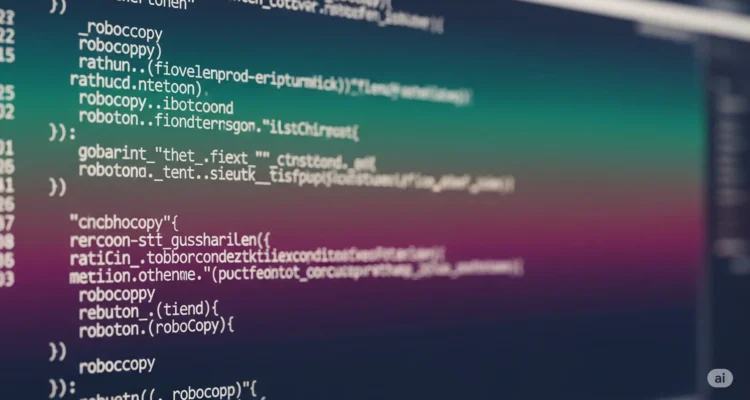Robocopy (Robust File Copy) is one of Windows’ most powerful file synchronization tools, but its mirror function can be both a blessing and a curse. When used correctly, robocopy mirroring creates perfect folder replicas for backups and synchronization. However, one wrong command can lead to catastrophic data loss. This comprehensive guide will teach you how to safely mirror folders with robocopy while avoiding common pitfalls that could wipe out your files.
Also Read: Robocopy.exe

What Is Robocopy Mirror Function?
Robocopy’s mirror function (/MIR) creates an exact replica of the source directory at the destination. Unlike simple copying, mirroring ensures the destination folder matches the source completely by:
- Copying new and modified files from source to destination
- Deleting files in the destination that don’t exist in the source
- Removing empty directories that aren’t present in the source
- Maintaining file attributes, timestamps, and security permissions
This makes robocopy mirroring ideal for creating synchronized backups, but also potentially dangerous if misconfigured.
Basic Robocopy Mirror Syntax
The fundamental robocopy mirror command follows this structure:
robocopy "C:\Source\Folder" "D:\Destination\Folder" /MIR
However, this basic command lacks safety measures that could prevent data loss. Let’s explore safer alternatives.
Essential Safety Parameters for Robocopy Mirroring
Before running any mirror operation, always include these protective parameters:
1. Preview Mode (/L)
Always test your command first using the /L (List) parameter:
robocopy "C:\Source" "D:\Backup" /MIR /L
This shows exactly what robocopy would do without actually performing any operations.
2. Logging (/LOG)
Create detailed logs of all operations:
robocopy "C:\Source" "D:\Backup" /MIR /LOG:"C:\Logs\mirror_log.txt"
3. Retry Parameters (/R and /W)
Set reasonable retry attempts and wait times:
robocopy "C:\Source" "D:\Backup" /MIR /R:3 /W:10
Step-by-Step Safe Mirroring Process
Step 1: Prepare Your Environment
- Open Command Prompt as Administrator
- Navigate to a working directory for logs
- Verify source and destination paths exist
- Ensure sufficient disk space at destination
Step 2: Test with Preview Mode
Run your intended command with /L first:
robocopy "C:\Important\Documents" "E:\Mirror\Documents" /MIR /L /LOG:"mirror_preview.txt"
Review the preview log carefully to ensure expected behavior.
Step 3: Execute Safe Mirror Command
Use this comprehensive command structure:
robocopy "C:\Important\Documents" "E:\Mirror\Documents" /MIR /R:3 /W:10 /LOG:"mirror_execution.txt" /TEE
The /TEE parameter displays output on screen while logging to file.
Advanced Robocopy Mirror Parameters
File Attribute Control
/COPYALL– Copies all file information (default for /MIR)/DCOPY:DAT– Copies directory timestamps and attributes/SECFIX– Fixes file security on existing files
Performance Optimization
/MT:8– Uses multi-threading (1-128 threads)/J– Uses unbuffered I/O for large files/COMPRESS– Enables network compression
Selective Mirroring
/XD folder1 folder2– Excludes specific directories/XF *.tmp *.log– Excludes files by pattern/MAXAGE:30– Only copies files newer than 30 days
Common Data Loss Scenarios and Prevention
Scenario 1: Swapped Source and Destination
Dangerous Command:
robocopy "D:\Backup" "C:\Important\Documents" /MIR
This would overwrite your important documents with backup files.
Prevention: Always double-check parameter order and use /L first.
Scenario 2: Wrong Destination Path
Dangerous Command:
robocopy "C:\Documents" "C:\" /MIR
This could mirror documents to the root C: drive, potentially deleting system files.
Prevention: Use full, explicit paths and verify destination existence.
Scenario 3: Network Path Issues
Dangerous Command:
robocopy "C:\Local" "\\Server\Share\Wrong\Path" /MIR
Network interruptions could cause partial syncing or corruption.
Prevention: Test network connectivity and use UNC paths carefully.
Best Practices for Safe Robocopy Mirroring
Before Running Mirror Commands
- Create a backup of your destination folder
- Test with /L parameter on a small subset first
- Verify paths are correct and accessible
- Check available disk space at destination
- Close applications that might lock files
During Mirror Operations
- Monitor progress through logs or console output
- Don’t interrupt the process unless absolutely necessary
- Watch for error messages and unusual behavior
- Verify network stability for remote destinations
After Mirror Completion
- Review log files for errors or warnings
- Verify file counts match between source and destination
- Test file accessibility at destination
- Check for missing or corrupted files
Troubleshooting Common Robocopy Mirror Issues
“Access Denied” Errors
Run Command Prompt as Administrator and ensure you have permissions to both source and destination folders.
“Path Too Long” Errors
Use the /256 parameter to enable long path support, or consider using shorter destination paths.
Network Timeout Issues
Increase retry counts (/R:10) and wait times (/W:30) for unreliable network connections.
Partial File Copies
Use /Z parameter for restartable mode on unreliable networks, though it’s slower.
Alternative Tools and When to Use Them
While robocopy is powerful, consider alternatives for specific scenarios:
- SyncToy – Microsoft’s GUI-based synchronization tool
- FreeFileSync – Cross-platform with visual comparison
- rsync – Linux-style synchronization with Windows ports
- Backup software – For comprehensive backup solutions with versioning
Conclusion
Robocopy mirroring is an incredibly powerful tool for maintaining synchronized folder structures, but it requires careful handling to avoid data loss. Always start with preview mode, use comprehensive logging, and double-check your source and destination paths. Remember that mirroring is destructive by nature – it will delete files in the destination that don’t exist in the source.
By following the safety practices outlined in this guide, you can harness robocopy’s mirroring capabilities while protecting your valuable data. Whether you’re creating system backups, synchronizing project folders, or maintaining server replicas, robocopy mirroring can be your reliable solution when used with proper precautions.
Remember: when in doubt, test first with /L, backup your destination, and never run robocopy mirror commands without understanding exactly what they will do.
Author is a passionate Blogger and Writer at Dlightdaily . Dlightdaily produces self researched quality and well explained content regarding HowToGuide, Technology and Management Tips&Tricks.
